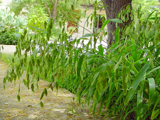Native Plants

Q. Who is Mr. Smarty Plants?
A: There are those who suspect Wildflower Center volunteers are the culpable and capable culprits. Yet, others think staff members play some, albeit small, role. You can torture us with your plant questions, but we will never reveal the Green Guru's secret identity.
Did you know you can access the Native Plant Information Network with your web-enabled smartphone?
Ask Mr. Smarty Plants is a free service provided by the staff and volunteers at the Lady Bird Johnson Wildflower Center.

rate this answer
Thursday - November 12, 2009
From: Kensington, MD
Region: Mid-Atlantic
Topic: Grasses or Grass-like
Title: Clearing up the nativity of so-called Baltimore sedge (Carex senta)
Answered by: Nan Hampton
QUESTION:
Dear Smarty Pants: Hi, did you ever get more clarity on the Carex senta issue (baltimore sedge)? Whether or not it was a wetland grass? I too am in Maryland and was thinking of planting it for a lawn, but not if it's only native way out west. If you have any other recommendation for a shade-loving native for a lawn, that would be wonderful. thanks in advance.ANSWER:
Carex senta (swamp carex) according to the USDA Plants Database is native to Arizona, New Mexico and California and according to the Flora of North America it grows along streams and in wet meadows in Arizona, California, and Mexico—not New Mexico. Someone apparently misidentified a sedge in New Mexico as C. senta when it was really Carex stricta (upright sedge). You obviously have read our previous question and answer concerning Carex senta but we still do not know why it is called 'Baltimore sedge' by some sources. USDA Plants Database says its common name is 'swamp carex' and Integrated Taxonomic Information System (ITIS) gives its common name as 'swamp carex' or 'swamp sedge'. Flora of North America didn't assign it a common name. If you have read Sedge Lawns for Every Landscape by John Greenlee (and I suspect you have), you know that he calls it 'Baltimore sedge', but we have no idea where he got the common name. The bottom line, however, is that Carex senta is not native to Maryland, despite its sometimes common name. We can, however, suggest some other shade-loving plants for lawns that are native to Maryland:
SEDGES AND GRASSES:
Carex blanda (eastern woodland sedge) and here are more photos and information and still more.
Carex pensylvanica (Pennsylvania sedge) and here are more photos and information and still more.
Muhlenbergia schreberi (nimblewill)
Chasmanthium latifolium (Inland sea oats), wouldn't be considered a turf grass, but it is very attractive even after seed heads have set.
Sorghastrum nutans (Indiangrass) is a tall attractive clumping grass.
GROUNDCOVER-TYPE WOODY AND HERBACEOUS PLANTS:
Gaultheria procumbens (eastern teaberry) evergreen.
Cornus canadensis (bunchberry dogwood)
Geum canadense (white avens) evergreen.
Linnaea borealis (twinflower) evergreen.
Mitchella repens (partridgeberry) evergreen.
Packera obovata (roundleaf ragwort) evergreen.
Tiarella cordifolia (heartleaf foamflower)
PHOTOS FROM OUR IMAGE GALLERY:
More Grasses or Grass-like Questions
Native Hill Country grasses, flowers for April garden show
March 17, 2005 - I will be a first ever (!) exhibitor in my garden club's garden show this April 7. Our theme is The Passion of Texas - my specific category is The Hill Country. Help!!! All materials I use must be al...
view the full question and answer
Plants for narrow strip between sidewalk and fence
May 01, 2008 - I have a strip of land about 5 inches wide and 30 feet long -- between the fence and the sidewalk -- that I would like to plant something that would look nice and wouldn't require the weedeater every...
view the full question and answer
Planting of Habiturf from Smithville TX
March 25, 2012 - Are Habiturf and Thunderturf the same?
and, how late in the year can I plant Habiturf?
view the full question and answer
Landscaping suggestions for small yard in Alexandria, VA
April 20, 2008 - Hi Mr. Smarty Plants,
My husband and I are preparing to till up most of our back yard and redo it. I'd like to use native plants, but am open to cultivars of them (as in, a column-shaped Ilex glabra...
view the full question and answer
Growing grasses under juniper trees (Juniperus ashei)
October 29, 2008 - Mr. Smarty Plants,
Yesterday, I attended the plant sale at the Wildflower Center. I purchased cupgrass and switchgrass seeds only to discover the grasses may need more water than I am willing to u...
view the full question and answer
| Support the Wildflower Center by Donating Online or Becoming a Member today. |

